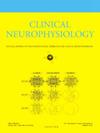Intraoperative monitoring of trigemino-palatal responses
IF 3.6
3区 医学
Q1 CLINICAL NEUROLOGY
引用次数: 0
Abstract
Objective
Our study aim was to describe the methodology for intraoperative recording of trigemino-palatal responses during posterior fossa surgeries.
Methods
Trigeminal nerve stimuli (2–4 pulses with 200–500 µs duration, 2 ms inter-stimulus interval, 25–50 mA) was applied to V3 under the zygomatic arch. Responses were recorded through needle electrodes inserted bilaterally in the soft palate, and through surface electrodes embedded in the endotracheal tube. Onset latency (L), duration (D) and peak-to-peak amplitude (A) were measured in each triggered response.
Results
The trigemino-palatal responses were successfully recorded in 23 out of 38 patients, bilateral in 12 of them. Response data (mean and IC 95 %) were L: 42 ms [35–57 ms]; D:45 ms [23–61 ms]; A:67 µs [57–183 µs]. Vocal cords responses were also recorded to trigeminal V3 stimulation in six patients with L:40 ms [37–47 ms]; D:25 ms [18–65 ms], and A: 70 µs [37–96 µs].
Conclusion
Trigemino-palatal responses were obtained under general anesthesia and used for the monitorization of patients submitted to posterior fossa surgery. Further studies are needed to foster the use of these responses for intraoperative monitorization.
Significance
Trigeminal V2/V3 branches trigger brainstem palatal responses that remain obtainable after general anesthesia.
术中三叉-腭反应监测
目的探讨后窝手术中三叉神经-腭部反应的术中记录方法。方法对颧弓下V3进行2 - 4次脉冲刺激,脉冲持续时间200-500µs,间隔2 ms, 25-50 mA。通过双侧软腭插入电极针和嵌入气管内管的表面电极记录反应。测量每个触发反应的发作潜伏期(L)、持续时间(D)和峰间振幅(A)。结果38例患者中23例成功记录三叉-腭部反应,其中12例为双侧反应。反应数据(平均值和IC 95%)为L: 42 ms [35-57 ms];D:45 ms [23-61 ms];A:67µs[57 ~ 183µs]。同时记录6例患者在L:40 ms [37-47 ms]时对三叉神经V3的声带反应;D:25 ms [18-65 ms], A: 70µs[37-96µs]。结论全麻下三叉-腭神经反应可用于后窝手术患者的监测。需要进一步的研究来促进这些反应在术中监测中的应用。三叉神经V2/V3分支触发脑干腭部反应在全麻后仍可获得。
本文章由计算机程序翻译,如有差异,请以英文原文为准。
求助全文
约1分钟内获得全文
求助全文
来源期刊

Clinical Neurophysiology
医学-临床神经学
CiteScore
8.70
自引率
6.40%
发文量
932
审稿时长
59 days
期刊介绍:
As of January 1999, The journal Electroencephalography and Clinical Neurophysiology, and its two sections Electromyography and Motor Control and Evoked Potentials have amalgamated to become this journal - Clinical Neurophysiology.
Clinical Neurophysiology is the official journal of the International Federation of Clinical Neurophysiology, the Brazilian Society of Clinical Neurophysiology, the Czech Society of Clinical Neurophysiology, the Italian Clinical Neurophysiology Society and the International Society of Intraoperative Neurophysiology.The journal is dedicated to fostering research and disseminating information on all aspects of both normal and abnormal functioning of the nervous system. The key aim of the publication is to disseminate scholarly reports on the pathophysiology underlying diseases of the central and peripheral nervous system of human patients. Clinical trials that use neurophysiological measures to document change are encouraged, as are manuscripts reporting data on integrated neuroimaging of central nervous function including, but not limited to, functional MRI, MEG, EEG, PET and other neuroimaging modalities.
 求助内容:
求助内容: 应助结果提醒方式:
应助结果提醒方式:


